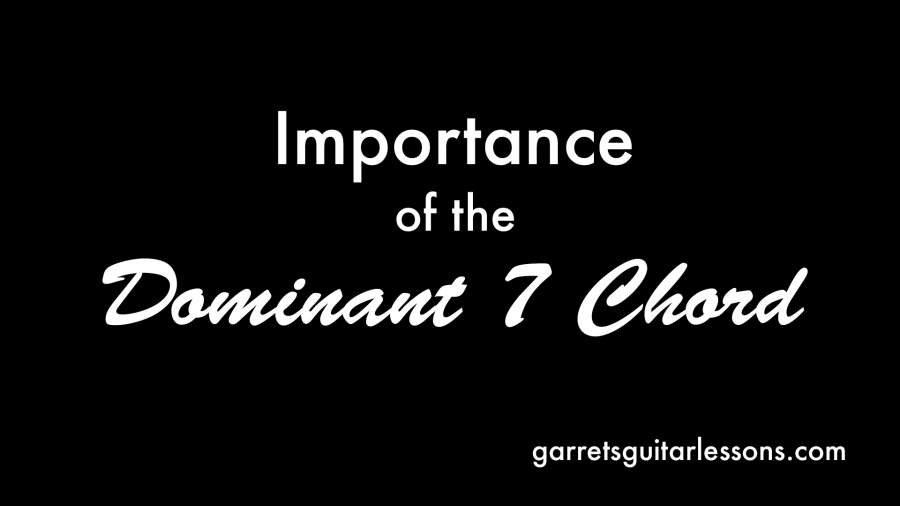The Dominant 7 Chord is probably one of the coolest chords of them all and also one of the most important chords of them all. Why you ask? Because it’s telling you what key your in and gives you a big hint on what chord is next.
How to Build a Dominant 7 Chord
How we build it is very similar to how we build any chord, we start stacking 3rds! Only this time we flat the 7th note. So the formula for a Dominant 7 is:
1 – 3 – 5 – b7
Use my Theory sheet as a reference guide for the notes (the first line) of each scale. So to build a C7 chord, we follow the top line under the “Key of C” and plug in those notes:
C – E – G – Bb (have to flat that 7th!)
Key of F: F – A – C – Eb
Key of G: G – B – D – F
Key of D: D – F# – A – C
And that’s how it’s done! Add a major triad and a flatted 7th and that’s how we get our dominant 7 chord.
*I have video series called “Usable Guitar Theory” (or UGT for short) I’d recommend if some of this goes over your head on my Free Lessons page and clicking on Theory. The few that talks about this are: “Building Chords?!” and “Extended Chords?!”
How to Spot a Dominant 7 Chord
To spot a Dominant 7 Chord, we’re looking for chords that don’t have any major, minors or any other business between the chord and it’s # (7, 9, 13). So something like this:
D7
G13
C9
Notice how it’s not Dm7, Gmaj13 or Cadd9? That’s telling us our chord is a dominant.
*Video lesson on “Naming a Chord?!“.
It’s even a dominant 7 if there’s a bunch of business after the initial chord. For example:
D7#9
G7#5b9
C9b13
It doesn’t matter what’s after the 7, 9, 13 all that matters is it’s not major (maj) or minor (m), it’s dominant.
Here are Video Lessons on playing Open 7 Chords, Barred 7th Chords and Extended Chords that has Dominant 7th’s sprinkled in and even Inversions of the Dominant 7 Chord.
How It Tells You What Key Your In
Unlike other 7th chords, this type of 7th chord is only found once in each key. Take another look at my Theory sheet and go through the 3rd line of each key (4 note chord). You’ll notice that the dominant 7th only happens once as the V (or 5) chord. Since it only happens once, once you see a dominant 7, you’ll immediately know what key you’re in.
When you see a G7, that only happens in the key of C. We’re in C.
When you see a C7, that only happens in the key of F. We’re in F.
When you see a D7, that only happens in the key of G. We’re in G.
*You’ll also notice the vii chord only once. I have another blog explaining why I always skip that chord when talking about Usable Guitar Theory.
How it Tells You Where It’s Going
This goes hand in hand with the last thing I talked about, but this is to address seeing more than one dominant 7 in a chord progression. For this example, I’ll use “Something” by the Beatles verse progression:
C – Cmaj7 – C7 – F – D7 – G
Notice C7 is leading you to the F Chord, then D7 is leading you to the G chord. These chords are temporarily pulling us to that chord or ‘key’. The chord that it’s leading us to is in the key of C, but the pull to the chord in the key of C is stronger.
Another thing is, the dominant chord leads us to either the Major or Minor version of that key. So the dominant 7 of Fm is C7 and the dominant of Gm is D7. So it might not tell us exactly where we’re going, but it’s giving us a great hint.
Taking that a step further, if we want to add a cool chord to a song we’re writing, add the dominant of a chord in the key. Example:
Key of C chords: C – Dm – Em – F – G – Am
Dominant of Dm = A7
Dominant of Em = B7
Dominant of F = C7
Dominant of G = D7
Dominant of Am = E7
Hope this gives you some insight on how to use and analyze our Dominant 7 Chord.

